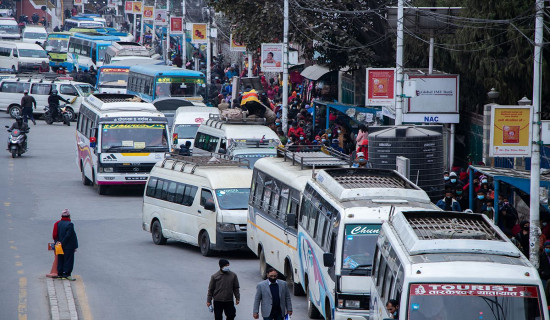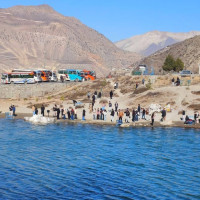- Thursday, 22 January 2026
One Year of Government Special Supplement
Addressing Nepal's Climate Vulnerability
Nepal, situated within the vulnerable Himalayan Mountain Range, is widely acknowledged as being susceptible to the effects of climate change. The June 2021 Melamchi River flood, triggered by increased northern region precipitation at the very onset of the monsoon, caused extensive loss of life and infrastructure. The August 2023 Kagbeni River flood, resulting from an upstream landslide, displaced 150 people and destroyed 29 houses. Moreover, a three-day post-monsoon rainfall in October 2021 incurred a record Rs. 8.26 billion losses, affecting 85,580 hectares of ready-to-harvest paddy crops. These events highlight Nepal's susceptibility to climate disasters, necessitating urgent adaptation measures. The nation's recurring struggles underscore the imperative to address climate issues comprehensively, acknowledging the evolving environmental threats it faces.
Global concerns
Observing the tangible impacts of climate change in Nepal's mountains and lowlands, an urgent plea has been made to the global community to halt climate-related activities and extend support to nations like Nepal, bearing the brunt of climate change despite being minor contributors to the issue.
During his visit to Nepal from 29 October 2023, UN Secretary-General Antonio Guterres also acknowledged that the mountains, essential water sources, have felt the impact of climate change.
Within this backdrop, Prime Minister Pushpa Kamal Dahal 'Prachanda' addressed COP28 summit in Dubai, emphasising the alarming rise of disasters in mountain regions and calling for immediate measures to safeguard these vulnerable landscapes.
Nepal actively participated in the COP events for many years, with the recently concluded session being deemed particularly significant. The Prime Minister addressed the global community, emphasising the urgency to address the impact of climate change, especially on developing nations like Nepal. He amply highlighted the climate crisis faced by mountainous countries.
The Dubai climate summit is taken as one of the milestones as it commenced with a landmark agreement on a loss and damage fund, aimed at assisting developing countries in dealing with the impacts of climate change.
Delegates reached this consensus on the conference's opening day, with various nations, including the host United Arab Emirates, Germany, and the United States, pledging financial support to the fund.
Since its agreement, the loss and damage fund has garnered around USD 800 million in pledges from various countries. Notable contributors include the United Arab Emirates, with a commitment of USD 100 million, the United Kingdom pledging GBP 40 million for the fund and GBP 20 million for other funding arrangements, Japan committing USD 10 million, the United States of America committing USD 17.5 million, and the European Union, including Germany, committing 225 million euros.
The fund aims to aid developing nations, especially those highly susceptibles to climate change impacts, in addressing both economic and non-economic losses associated with extreme weather events and gradual environmental changes.
Securing funds
Manjeet Dhakal, Head of the Least Developed Countries (LDC) Support Team at the Climate Analytics (CA), said that the journey to secure loss and damage funds is still a long way to go. While acknowledging the historical significance of the recent COP28 for LDCs, he added that a substantial amount of work remains to be done. Efforts need to be intensified within the country and there is necessity of further groundwork to facilitate the securing of necessary funds.
"So far, about US$800 million has been committed to the loss and damage fund." While it is a good beginning, the actual damage is expected to be in the trillions. The fund will not be distributed right away; it needs time for various stages of process and procedures. It might take up to three to four months just to set up the Board before the fund becomes operational," according to Dhakal.
Before asking for international help with loss and damage funds, there is a lot of work to be done at home, and it might take two to three years to get ready.
We need to study and plan the programmes that need funding. Getting the money will not be easy, so we should set up a body to handle the entire process and use the funds wisely.
Buddhi Poudel, Chief of the Climate Change Division under the Ministry of Forest and Environment, also agrees that getting a climate funds is not easy. We need a plan for both short and long-term funds and should provide study based scientific proof and assessments to claim the right amount.
The government is currently examining programmes and figuring out how to access climate funds through its mechanisms. To secure the funds, scientific evidence is crucial, prompting the government to plan involvement with the scientific community.
Towards net zero
Nepal had submitted its second Nationally Determined Contribution (NDC) at COP26 for the period 2021-2030 under the Paris Agreement, underscoring a dual focus on adaptation and mitigation strategies. With a distinctive emphasis on adaptation, Nepal's NDC reflects the nation's climate priorities. Key priorities include expanding clean energy generation ranging from 1,400 MW to 15,000 MW by 2030, with 5 to 10 per cent from mini and micro-hydro plants, solar, wind, and bio-energy. The unconditional target is set at 5,000 MW, and the aim is to meet 15 per cent of total energy demand through clean energy sources.
In the transport sector, ambitious goals include achieving 25 per cent sales of electric vehicles (EVs) for private passenger vehicles and 20 per cent for public passenger vehicles by 2025. By 2030, the plan is to cover 90 per cent of private passenger vehicle sales and 60 per cent of public passenger vehicle sales with e-vehicles, reducing fossil fuel dependency and emissions significantly.
Other objectives include the development of a 200 km electric rail network, promoting the use of electric stoves in 25 per cent of households by 2030, and installing 500,000 improved cookstoves by 2025. The government also aims to establish 200,000 household biogas plants and 500 large-scale biogas plants by 2025, while maintaining 45 per cent forest cover by 2030, supported by funding from REDD+ initiatives.
Additionally, Nepal has formulated the Nepal National Adaptation Plan (2021-2050), a pivotal framework integrating climate adaptation across government sectors. Aligned with the Second NDC, this plan addresses short medium and long-term goals, enhancing resilience and mitigating vulnerabilities in development planning while meeting Nepal's obligations under the Paris Agreement and the United Nations Framework Convention on Climate Change (UNFCCC).
(Aryal is a journalist at The Rising Nepal.)
















